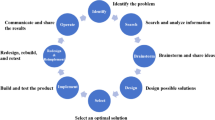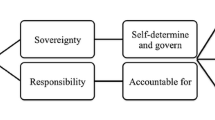Abstract
The role of creativity has been well recognized in wholesome development of children’s personality and attitude. Among various approaches to foster creativity in children, design thinking (DT) has emerged as a significant approach. The study presented in this paper explores the implementation of DT into maker education to help K-12 students acquire creativity effectively. Majority of the studies in the literature have measured students’ creativity using a traditional creative ability scale, instead of work performance or both. We proposed a Three-Stage DT Framework (TSDTF) suitable for maker education, which has three stages, namely pre-design, in-design and post-design. TSDTF provides more specificity to indicate students’ learning process iteratively. Then we applied TSDTF to the 3D model-design curriculum to see the impact on the students’ work performance, learning achievement, and creativity ability. The study engaged two sixth-grade classes, with a total of 90 students, wherein the experimental group (45 students) was taught using TSDTF and the control group (45 students) was taught with traditional pedagogy. The results showed that there was no significant difference in basic knowledge of learning achievements for the students in both groups, while the students in the experimental group improved their work performance, operational skill of learning achievements, and creative ability more significantly than those in the control group. The qualitative analysis of the interview data revealed that the DT approach helped the students to be creative, thus enabling them to develop innovative works. The study showed that it is important for teachers to utilize the DT learning strategy in maker education in developing the students’ creative thinking.







Similar content being viewed by others
Data availability
Data available on request from the authors.
References
Balakrishnan, B. (2021). Exploring the impact of design thinking tool among design undergraduates: A study on creative skills and motivation to think creatively. International Journal of Technology and Design Education. https://doi.org/10.1007/s10798-021-09652-y
Bevan, B. (2017). The promise and the promises of making in science education. Studies in Science Education. https://doi.org/10.1080/03057267.2016.1275380
Blikstein, P. (2013). Digital fabrication and ‘Making’ in education: the democratization of invention. In J. Walter-Herrmann & C. Büching (Eds.), FabLabs: Of Machines (pp. 1–22). Makers and Inventors, Transcript Publishers.
Braun, V., & Clarke, V. (2006). Using thematic analysis in psychology. Qualitative Research in Psychology, 3(2), 77–101. https://doi.org/10.1191/1478088706qp063oa
Brown, T. (2008). Design thinking. Harvard Business Review, 86(6), 84.
Carroll, M., Goldman, S., Britos, L., Koh, J., Royalty, A., & Hornstein, M. (2010). Destination, imagination and the fires within: Design thinking in a middle school classroom. International Journal of Art & Design Education, 29(1), 37–53. https://doi.org/10.1111/j.1476-8070.2010.01632.x
Choi, H. H., & Kim, M. J. (2016). The effects of analogical and metaphorical reasoning on design thinking. Thinking Skills and Creativity. https://doi.org/10.1016/j.tsc.2016.11.004
Cook, K. L., & Bush, S. B. (2018). Design thinking in integrated STEAM learning: Surveying the landscape and exploring exemplars in elementary grades. School Science and Mathematics, 118(3–4), 93–103. https://doi.org/10.1111/ssm.12268
Cropley, D. H., Kaufman, J. C., & Cropley, A. J. (2011). Measuring creativity for innovation management. Journal of Technology Management & Innovation, 6(3), 13–29. https://doi.org/10.4067/s0718-27242011000300002
Cutumisu, M., Schwartz, D. L., & Lou, N. M. (2020). The relation between academic achievement and the spontaneous use of design-thinking strategies. Computers & Education, 149(5), 1–42. https://doi.org/10.1016/j.compedu.2020.103806
Dorst, K. (2011). The core of 'design thinking’ and its application. Design Studies, 32, 521–532. https://doi.org/10.1016/j.destud.2011.07.006
Efeoglu, A., Møller, C., Sérié, M., & Boer, H. (2013). Design thinking: characteristics and promises. In: Proceedings 14th International Conference on “Business Development and Co-creation”, Enschede, Continuous Innovation Network (CINet), (pp. 241–256)
Fan, S. C. (2022). An importance–performance analysis (IPA) of teachers’ core competencies for implementing maker education in primary and secondary schools. International Journal of Technology and Design Education, 32, 943–969. https://doi.org/10.1007/s10798-020-09633-7
Godhe, A. L., Lilja, P., & Selwyn, N. (2019). Making sense of making: Critical issues in the integration of maker education into schools. Technology, Pedagogy and Education, 28(3), 317–328. https://doi.org/10.1080/1475939x.2019.1610040
Goldschmidt, G. (2016). Linkographic evidence for concurrent divergent and convergent thinking in creative design. Creativity Research Journal, 28(2), 115–122. https://doi.org/10.1080/10400419.2016.1162497
Halverson, E. R., & Sheridan, K. (2014). The maker movement in education. Harvard Educational Review, 84(4), 495–504. https://doi.org/10.17763/haer.84.4.34j1g68140382063
Hatzigianni, M., Stevenson, M., Falloon, G., Bower, M., & Forbes, A. (2021). Young children’s design thinking skills in makerspaces. International Journal of Child-Computer Interaction, 27(5), 1–11. https://doi.org/10.1016/j.ijcci.2020.100216
Hee Kim, K. (2006). Is creativity unidimensional or multidimensional? Analyses of the torrance tests of creative thinking. Creativity Research Journal, 18(3), 251–259. https://doi.org/10.1207/s15326934crj1803_2
Henriksen, D., Richardson, C., & Mehta, R. (2017). Design thinking: A creative approach to educational problems of practice. Thinking Skills and Creativity, 26, 140–153. https://doi.org/10.1016/j.tsc.2017.10.001
Hsu, Y. C., Baldwin, S., & Ching, Y. H. (2017). Learning through making and maker education. TechTrends, 61, 589–594. https://doi.org/10.1007/s11528-017-0172-6
Hughes, J., Morrison, L., Kajamaa, A., & Kumpulainen, K. (2019). Makerspaces promoting students’ design thinking and collective knowledge creation: Examples from Canada and Finland. In A. L. Brooks, E. Brooks, & C. Sylla (Eds.), Interactivity, Game Creation, Design, Learning, and Innovation (pp. 343–352). Cham: Springer. https://doi.org/10.1007/978-3-030-06134-0_38
Kafai, Y., Fields, D., & Searle, K. (2014). Electronic textiles as disruptive designs: Supporting and challenging maker activities in schools. Harvard Educational Review, 84(4), 532–556. https://doi.org/10.17763/haer.84.4.46m7372370214783
Liedtka, J. (2015). Perspective: Linking design thinking with innovation outcomes through cognitive bias reduction. Journal of Product Innovation Management, 32(6), 925–938. https://doi.org/10.1111/jpim.12163
Lin, L., Shadiev, R., Hwang, W. Y., & Shen, S. (2020). From knowledge and skills to digital works: An application of design thinking in the information technology course. Thinking Skills and Creativity. https://doi.org/10.1016/j.tsc.2020.100646
Luchs, M. G. (2015). A brief introduction to design thinking. In M. G. Luchs, K. Scott Swan, & A. Griffin (Eds.), Design Thinking: New Product Development Essentials from the PDMA (pp. 1–12). Wiley. https://doi.org/10.1002/9781119154273.ch1
Mechelen, M. V., Laenen, A., Zaman, B., Willems, B., & Abeele, V. V. (2019). Collaborative design thinking (codet): A co-design approach for high child-to-adult ratios. International Journal of Human-Computer Studies, 130, 179–195. https://doi.org/10.1016/j.ijhcs.2019.06.013
Nemorin, S., & Selwyn, N. (2017). Making the best of it? Exploring the realities of 3D printing in school. Research Papers in Education, 32(5), 578–595. https://doi.org/10.1080/02671522.2016.1225802
Nusbaum, E. C., & Silvia, P. J. (2011). Are intelligence and creativity really so different?: Fluid intelligence, executive processes, and strategy use in divergent thinking. Intelligence, 39(1), 36–45. https://doi.org/10.1016/j.intell.2010.11.002
Papavlasopoulou, S., Giannakos, M. N., & Jaccheri, L. (2017). Empirical studies on the Maker movement, a promising approach to learning: A literature review. Entertainment Computing, 18, 57–78. https://doi.org/10.1016/j.entcom.2016.09.002
Papert, S. (1980). Mindstorms: Children, computers, and powerful ideas. Basic Books.
Plattner, H., Meinel, C., & Leifer, L. (Eds.). (2012). Design thinking research. Springer. https://doi.org/10.1007/978-3-319-60967-6
Rauth, I., Köpen, E., Jobst, B., & Meinel, C. (2010). Design thinking: An educational model towards creative confidence. In: Proceedings of the 1st International Conference on Design Creativity. Retrieved from https://www.designsociety.org
Schad, M., & Jones, W. M. (2020). The maker movement and education: A systematic review of the literature. Journal of Research on Technology in Education, 52(1), 65–78. https://doi.org/10.1080/15391523.2019.1688739
Sheridan, K., Halverson, E. R., Litts, B., Brahms, L., Jacobs-Priebe, L., & Owens, T. (2014). Learning in the making: A comparative case study of three makerspaces. Harvard Educational Review, 84(4), 505–531. https://doi.org/10.17763/haer.84.4.brr34733723j648u
Sung, E., & Kelley, T. R. (2019). Identifying design process patterns: A sequential analysis study of design thinking. International Journal of Technology and Design Education, 29, 283–302. https://doi.org/10.1007/s10798-018-9448-1
Torrance, E. P. (1974). The Torrance tests of creative thinking-TTCT Manual and Scoring Guide: Verbal test A, figural test. Ginn.
van Dijk, G., van der Meij, A., & Savelsbergh, E. (2020). Maker Education: Opportunities and threats for Engineering and Technology Education. In P. Williams & D. Barlex (Eds.), Pedagogy for Technology Education in Secondary Schools. Springer.
Vossoughi, S., Escudé, M., Kong F., & Hooper, P. (2013). Tinkering, learning & equity in the after-school setting. In annual FabLearn conference. Palo Alto, Stanford University.
Vossoughi, S., & Bevan, B. (2014). Making and tinkering: A review of the literature. National Research Council Committee on out of School Time STEM, 67, 1–55.
Wilson, L. (2003). Breaking into the universe: Computer science is interactive entertainment. Computers in Entertainment, 1(1), 1–7. https://doi.org/10.1145/950566.950586
Wright, L., Shaw, D., Gaidos, K., Lyman, G., & Sorey, T. (2018). 3D pit stop printing. Science and Children, 55(7), 55–63. https://doi.org/10.2505/4/sc18_055_07_55
Wu, T. T., & Wu, Y. T. (2020). Applying project-based learning and SCAMPER teaching strategies in engineering education to explore the influence of creativity on cognition, personal motivation, and personality traits. Thinking Skills and Creativity. https://doi.org/10.1016/j.tsc.2020.100631
Yoon, C. H. (2017). A validation study of the Torrance Tests of Creative Thinking with a sample of Korean elementary school students. Thinking Skills and Creativity, 26, 38–50. https://doi.org/10.1016/j.tsc.2017.05.004
Funding
National Natural Science Foundation of China, 62307026, Lei Wu,Shandong Provincial Natural Science Foundation, ZR2021QF069, Lei Wu.
Author information
Authors and Affiliations
Corresponding author
Ethics declarations
Conflict of interest
The authors declare that they have no conflict of interest.
Research involving human participants and animals
This article does not contain any studies with human participants or animals performed by any of the authors.
Additional information
Publisher's Note
Springer Nature remains neutral with regard to jurisdictional claims in published maps and institutional affiliations.
Appendix: 3D work evaluation scale
Appendix: 3D work evaluation scale
The 3D Work Evaluation Scale assesses the “Novelty” and “Elegance” aspects of a model based on specific criteria. Participants rate each item on a 5-point Likert-type scale, ranging from “not at all” to “very much”. Here’s a breakdown of these criteria:
Novelty
-
1.
The model draws attention to the user’s demand.
-
2.
The model shows how existing works could be improved.
-
3.
The model helps the user anticipate the likely effects of changes.
-
4.
The model uses existing knowledge to generate novelty.
-
5.
The model makes use of new mixtures of existing elements.
-
6.
The model uses existing 3D software functions to generate unique features.
-
7.
The model uses existing 3D software functions to generate original features.
-
8.
The model uses existing 3D software functions to generate unusual features.
-
9.
The model demonstrates a radically new design idea.
-
10.
The model demonstrates new and different ways of using the software.
-
11.
The model offers a fundamentally new perspective on possible designs.
Elegance
-
1.
The model makes sense.
-
2.
The model is neat and well done.
-
3.
The model is well worked out.
-
4.
The model is well-proportioned and nicely formed.
-
5.
The elements of the model fit together in a consistent way.
-
6.
The color and material of the model look very harmonious.
-
7.
The model is skillfully executed and well-finished.
Rights and permissions
Springer Nature or its licensor (e.g. a society or other partner) holds exclusive rights to this article under a publishing agreement with the author(s) or other rightsholder(s); author self-archiving of the accepted manuscript version of this article is solely governed by the terms of such publishing agreement and applicable law.
About this article
Cite this article
Tan, J., Kinshuk & Wu, L. The effectiveness of design thinking on K-12 school students’ creativity in a maker curriculum. Education Tech Research Dev (2023). https://doi.org/10.1007/s11423-023-10332-y
Accepted:
Published:
DOI: https://doi.org/10.1007/s11423-023-10332-y




